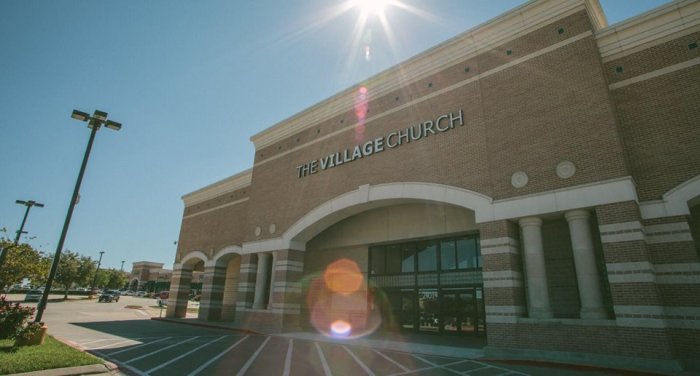Why many multisite churches are now moving toward autonomous congregations

Pastor David Chadwick was torn when he raised the question as he stepped down from Forest Hill Church in Charlotte, North Carolina, in the final weeks of winter.
“Churches all over the country are doing it with videos shown on the screen in other places,” he said in March. “Elevation (Church) is probably the primary example here in Charlotte. You know, I just began to wonder more and more — how effective is that?”
For nearly 40 years, Chadwick had led the 4,000-member, six-campus ministry which he had built from a 180-member congregation. As he ended his tenure at the church, however, Chadwick revealed he had started to have doubts about Forest Hill’s multisite model where lead pastors mainly connect with the congregation through video.
“I know I’m a good communicator … I can have people come and listen. But doesn’t a pastor need to speak to his people? I began to struggle with that,” he admitted.
At the time, said Chadwick, Forest Hill had already begun considering making each of the church’s campus pastors more autonomous.
As of 2012, multisite churches – congregations that host worship services at more than one physical location – numbered more than 5,000 in the U.S.
While Chadwick and several leaders of multisite congregations contacted by The Christian Post have declined to publicly comment on a growing discussion among the cohort on transitioning to autonomous churches, experts with knowledge of the industry say it is happening.
The popular multisite NewSpring Church in South Carolina, which struggled after founder Perry Noble was fired in 2016 for alcoholism and other failures, declined to speak about their own experience with the model.

The church’s chief communications officer, Suzanne Swift, said, however, that she is aware that “many [multisite] churches are considering” transitioning to autonomous congregations.
Concerns
Paul Marzahn, senior pastor of Crossroads Church, a multisite operation in Lakeville, Minnesota, told CP that he and other ministers have been studying the phenomenon for a while. He highlighted several reasons why he believes many multisite churches are looking at transitioning to autonomous churches.
“It’s a valid concern on a couple fronts. One is, some fairly large churches have had moral failures, and if you have your whole system based on one person primarily, … if that person fails then the whole system goes down,” he said, acknowledging ongoing turmoil at Willow Creek Community Church and more recently Harvest Bible Chapel in Illinois.
“There’s an economic and just kind of a practical aspect. The system is set up pretty much on a personality of one pastor who is highly effective, but if that highly effective pastor has any moral issues or even dysfunction – depression, alcoholism – it can really shut down all the campuses,” he said.
While some multisite churches, like Rick Warren’s global Saddleback Church based in California, have systems in place to deal with stressors that can affect leadership, some don’t, said Marzahn.
“I think there has been some exceptions to that. For example, Rick Warren, I know him personally. When his son committed suicide, he almost took a whole year off but he had a system in place to handle that. Not every multisite does,” Marzahn explained.
He noted too that the typical multisite church model may not always serve young church leaders well.
“At the doctoral study level, we’re talking about how do you train, raise up and even disciple the next generation of teaching pastors and effective pastors? And this kind of sidesteps that approach. It’s sort of like saying we’re not going to take the time to mentor and train and raise up other really effective communicators. We’re going to take our best communicators and just multiply that by campuses [aided] by video screens,” he said.
“Personally, I’ve tackled that one where I started with some video screen campuses and now through internship programs, mentoring and teaching, I’ve seen the value in raising up the next generation of teachers. I think Andy Stanley has been doing that too; it’s a great example of kind of having a common theme or element that all the campuses are doing but allowing the live preaching to take the major tenets of that message,” Marzahn explained.
The Minnesota leader said he believes many multisite church leaders are avoiding discussing the issue publicly because they do not want to be seen as having a problem.
“I think there is a fear factor. Organizations like that, if you’re breaking up, something’s wrong because there have been ones that have had moral failures, there have been ones who are breaking up because of a problem that they don’t want that association maybe. I think they should just be bold and say, 'Hey, we’re thinking we’re changing our model,'” he said.
“Willow Creek came out with a survey several years ago called ‘Reveal.’ They realized that their … approach wasn’t producing disciples and they finally said, 'You know what? You’re right. We’re a shallow church; we need change.' And they just owned up to it and said,'Our model isn’t working and so because this model isn’t producing disciples we’re going to change our model.' And I think there are some campuses that aren’t producing disciples."
Speaking from his own experience with the multisite church model, Marzahn said he wouldn’t classify trying, then moving on from it as a failure.
“I wouldn’t say they failed. I think it was a bold experiment. I think they still produced some disciples but it’s not as effective as it could be, so they’re re-evaluating that. But there are some churches who are afraid to say, 'Hey, maybe we made a mistake in planting a multisite the way we did it,'” he said.
He said he personally made a number of mistakes in how he implemented the model but has learned from them.
“I can just say, 'Hey, I did it with the best intentions but I’m learning as I go. I’ve never done it before.' I think the way we’re moving now is more healthy and I think it produces more disciples and it produces more leaders. That’s how I discussed it,” he said.
“It doesn’t mean in 2011 I was a bad pastor and egotistical and thought everybody should watch my videos. I just thought I want to start new churches, these churches are dying, I’m an effective teacher, a lot of these churches that I got complained they didn’t have effective teaching. As I got these churches going I thought well, I don’t need to be the only teacher. We can train up others and we can do this differently."
The Village Church transition
In 2017, The Village Church in Texas, led by Matt Chandler, pledged to transition all their campuses into autonomous churches by 2022 under a new initiative called Multiply.
Chandler said he had come to realize that the multisite model comes with an expiration date.
“In the years in which we felt the most stress, the most pressure at The Village Church, we were out of space. We didn’t know what else to do except enter into a season of prayer and fasting and just ask the Lord to do something that we had not been able to figure out by ourselves,” he said. “That started multisite for us in which we believe God was saying, ‘Hey, in this season, the life of the church, this is how you’re going to make disciples, this is how I’m going to move and bless The Village Church.' … We ended up with five campuses and all of them doing really well in regards to reaching their local contexts. It’s just really been a rich beautiful season.”
Beau Hughes, pastor of The Village Church Denton, the first campus of The Village Church to become autonomous, said that from the outset of their multisite journey, Chandler did not settle on the model as a long-term plan.
“I remember Matt even saying in one of the first meetings that we weren’t even sure where this was heading and eventually it might even head toward the campus becoming a local church. So as that moved on in terms of just our life together, that conversation was always there at least on Matt’s heart in so many different ways, about what to do with the campus long term,” he said.
After much prayer and eight years after starting as a campus, The Village Church Denton transitioned into a local church.
“The success of the Denton church, watching them really in a contextual place be freed up to engage where they were was really a beautiful thing and it shone light on how we were doing ministry and it shone some light on weaknesses that this thing that we’re doing, as beautiful as it is, it’s got an expiration date,” Chandler said.
He said they continued to pray about what was happening until all the elders of the church came to a unanimous decision to work toward making all five campuses of The Village Church autonomous by 2022. This would allow for increased localized and global missions and those churches could also move on to plant more churches as well.
In recent responses to questions from CP, David Roark, communications and resources director at The Village Church, said two more campuses will make the transition to autonomous churches this year.
"On the whole, it's been going well," he said of the process.
"Two of our campuses, Plano and Dallas, will be transitioning off this year, and the staff and members of those churches are eager and excited about the future; in fact, the votes in favor to transition those campuses from members were both above 95 percent. The rest of the campuses are planning and putting the pieces in place to do the same in the next few years," he explained.
And while the transition has not been easy, Roark said, the transition team continues to move forward with grace.
"On the one hand, there is much momentum and excitement around Multiply, yet it's come with challenges. The general reality of saying 'goodbye' to people you've worked closely with for years and years is no small thing (we call these 'gospel goodbyes' because they're both extremely good and extremely hard), and there's just been a continued learning curve for each campus to start thinking more locally and individually in light of Multiply while also trying to remain connected and unified," he said. "That's not always easy and we've made mistakes, pushing too hard one way or the other, but I think we've all acknowledged the need to extend an extensive amount of grace to one another during this season."
The Village Church has been careful to note that their transition from the multisite model should not be interpreted as a critique but a capitalization on an opportunity.
When asked if the model would have been sustainable for The Village Church in the long term, Roark said he wasn’t sure. He was sure, however, that it wouldn’t have been as effective or healthy.
“I'm not sure if we can say whether or not it would have been sustainable (I'm sure we could make it work since we have for more than a decade), but I think we can say that it wouldn't be as effective and healthy,” he said. “That's not a broad statement about multisite, but it's a specific statement for us here. I can't speak for other multisite models, and it's good to recognize how they're all different with various strategies and contexts, but we believe releasing campuses to be local, autonomous churches gives everyone the best shot at local contextual ministry in the long term.”
Roark also shot down speculation that economics may have been part of the driving force behind the decision to transition away from the multisite model.
“That hasn't been a factor. In some ways, going in the direction of Multiply has caused some new financial challenges that we've not historically faced because giving and budgeting has always been centralized, and we're having to look at things differently in light of campus transitions,” he told CP.
After seeing the success of the Denton transition and driven by the Holy Spirit though, they remain inspired by the initial outcomes.
"We believe the Holy Spirit has been working through all these things, but it all started with the first campus that rolled off in Denton. They led by example, really stepping out in conviction and courage, and we quickly saw the fruit of that initial transition. There were some challenges for them no longer being a campus of The Village, but we saw the body of Christ, the members, stepping up in a way they never had, taking ownership, and we saw the flexibility and opportunity it gave the Denton church to be a city on a hill in their community that simply wasn't able to happen while they were a part of our multisite model," Roark said.
Even though the Southlake campus of The Village Church was the last one to be launched in 2016, the church has continued to expand in other ways.
"Beyond campus transitions, we planted four separate churches last year: three in Dallas Fort Worth [and] one in Rancho Cucamonga, California; we have two new church plants in the pipeline this year," he said. "Our focus now is to transition the rest of our campuses, with the timeline of 2022, while continuing to plant churches locally and globally and to train and send missionaries globally."
And while it's still early to draw hard conclusions, Roark explained that The Village Church's experience with the multisite model so far presents it as an effective "church planting strategy."
"We're right in the middle of things, still learning as we go. Yet with the fruit we've seen so far and even with the state of the broader culture, it seems as if the multisite model could be leveraged more and more as a church planting strategy, and that could be a really good thing for those local bodies and for their communities," he said.
Growing pains?
Marzahn likens the issues some churches have had with the multisite model as growing pains and believes it will endure as a viable model for churches into the future.
“I still think multisite has great potential if they can figure out a way to harness that side of the affiliation without it being so controlling from the top down,” he said.
“I really think they are [growing pains]. But what I hope doesn’t happen, because I’ve seen this happen, is the flipside backlash where the mother church [says], ‘Oh they’re going to take off on their own so good luck with that.' And they just cut them loose. I did that to one campus once a long time ago because I think I was immature and I’m just like 'my youth pastor wants to start a church' and I’m just like ‘good luck with that’ versus being mature and saying, 'How can I help you? How can I support you in this transition?'”





























